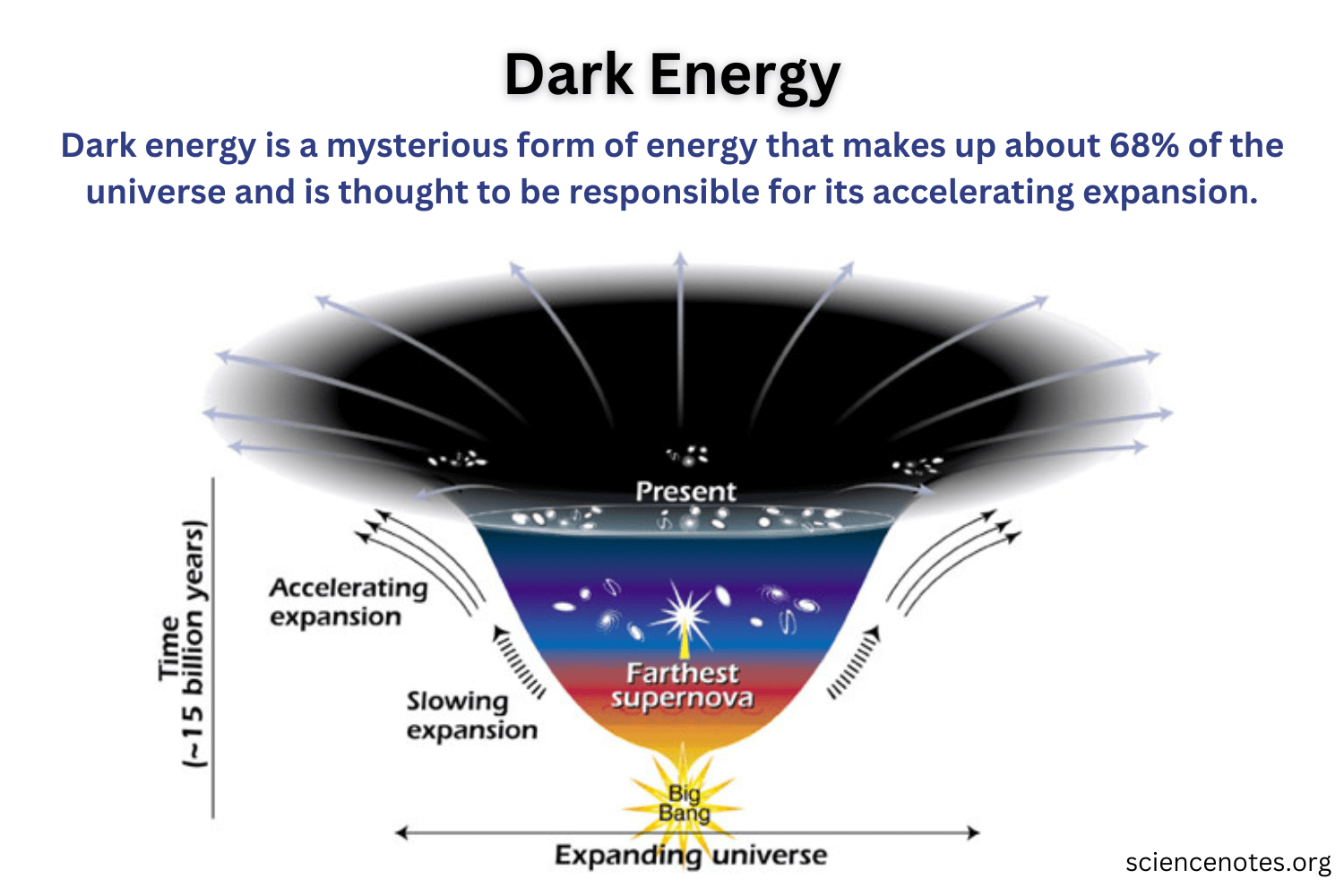Dark energy is a pivotal concept in understanding the mysteries of the universe and its expansion. This elusive force, often associated with the cosmological constant, is believed to drive the accelerating expansion of the cosmos. Recent findings from the international Dark Energy Spectroscopic Instrument (DESI) collaboration reveal that dark energy might not be as constant as previously thought, sparking innovative discussions on the fate of the universe. By analyzing Baryon Acoustic Oscillations and utilizing a comprehensive 3D map of galaxy evolution, researchers are uncovering clues that suggest dark energy’s influence may be changing over time. As scientists delve deeper into this research, the implications for our understanding of the universe’s structure and future become increasingly profound.
Often referred to as the force accelerating the expansion of the cosmos, dark energy is reshaping current astrophysical paradigms. The phenomenon related to this mysterious energy, referred to as the cosmological constant by many theoreticians, is central to contemporary studies of galaxy formation and distribution. Insights from the DESI collaborative effort highlight potential shifts in the characteristics of this force, inviting a re-evaluation of cosmic evolution theories. Furthermore, the inquiry into the role of Baryon Acoustic Oscillations illuminates the fabric of the universe, providing a unique perspective on how matter behaves over vast distances and time periods. This ongoing exploration is set to redefine foundational principles within cosmology, offering fresh interpretations of how our universe continues to unfold.
Understanding Dark Energy and Its Impact on Universe Expansion
Dark energy is a mysterious force that plays a crucial role in the accelerating expansion of the universe. It is often associated with the cosmological constant, a concept introduced by Albert Einstein in his theory of general relativity. Recent findings from the Dark Energy Spectroscopic Instrument (DESI) collaboration suggest that the properties of dark energy might not be as constant as previously thought. Instead, it could be evolving, which raises essential questions about the ultimate fate of the universe and how dark energy affects its expansion over time.
The relationship between dark energy and universe expansion is central to our understanding of cosmic dynamics. As DESI tracks the distribution of matter in the universe through the lens of Baryon Acoustic Oscillations, researchers gain insights into how dark energy influences galactic formations and the structure of the cosmos. This research not only challenges existing paradigms but also prompts a re-evaluation of the cosmological models used by astronomers and physicists alike.
The Role of the DESI Collaboration in Unraveling Cosmic Mysteries
The DESI collaboration, comprising over 900 researchers across more than 70 institutions, has been instrumental in advancing our knowledge of dark energy and its effects on the universe. This collaborative effort leverages the most extensive 3D mapping of the universe, allowing scientists to analyze the impact of dark energy over the last 11 billion years. By studying how galaxies, quasars, and other celestial objects are distributed, the team can uncover significant patterns that help quantify the influence of dark energy on cosmic expansion.
Researchers from institutions like the Center for Astrophysics | Harvard & Smithsonian have developed cutting-edge algorithms and simulations to interpret the data collected by DESI. These contributions highlight the synergy between technological advancement and collaborative research, reinforcing the importance of teamwork in tackling complex astrophysical questions. As DESI continues its mission, the insights gained will not only inform our understanding of dark energy but also enhance our grasp of galaxy evolution and the overall structure of the universe.
Baryon Acoustic Oscillations: A Key to Understanding Cosmic Expansion
Baryon Acoustic Oscillations (BAOs) are ripples in the density of visible matter in the universe, a result of sound waves traveling through the hot plasma in the early cosmos. These oscillations are vital as they provide a standard ruler for measuring cosmic distances. The DESI collaboration utilizes this phenomenon to track how dark energy has evolved and influenced galaxy formation over time. By analyzing the BAO patterns in the light from over 14 million galaxies and quasars, scientists can piece together a more accurate picture of cosmic expansion across the ages.
The ability to measure BAOs allows researchers to assess the strength of dark energy at various points in time and space. As the universe expands, the alterations in the size and distribution of these oscillations reflect changes in the influence of dark energy. This ongoing research may offer answers to critical questions surrounding the dynamics of cosmic expansion and the role of dark energy in shaping the universe’s fate, making BAOs an invaluable tool in modern cosmology.
Cosmological Constants: Are They Really Constant?
The cosmological constant has long been assumed to be a fundamental aspect of our universe’s structure, responsible for the repulsive force known as dark energy. However, new findings from the DESI collaboration indicate that this might not be the case. If dark energy is found to vary over time, it could fundamentally change our understanding of the physics governing cosmic expansion and introduce new implications for the fate of the universe.
This revelation aligns with other theoretical frameworks and observational data suggesting that the universe’s expansion is not just a result of a static force but may be influenced by dynamic factors. By revisiting earlier models and integrating the latest results from DESI, astrophysicists can develop more comprehensive theories that accommodate these fluctuations, enhancing our understanding of dark energy’s role in the larger cosmic narrative.
The Importance of Public Engagement in Astrophysical Research
One of the key aspects of the DESI collaboration is its commitment to public engagement and education. Researchers like Claire Lamman have been vital in creating materials that convey complex astrophysical concepts to the general public. As new data emerges, it is crucial to bridge the gap between the scientific community and society, fostering a broader understanding of issues like dark energy, galaxy evolution, and cosmological constants. This approach nurtures curiosity and promotes support for scientific exploration and innovation.
Moreover, making data from the DESI collaboration openly available allows students, educators, and amateur astronomers to explore the cosmos in ways previously unimaginable. The release of datasets, such as those facilitating studies of millions of celestial objects, empowers a new generation of scientists to engage with and contribute to the ongoing conversation about the universe’s expansion and its mysteries. Such initiatives highlight the collaborative nature of modern science, where knowledge is shared for collective advancement.
Galaxy Evolution and Its Connection to Dark Energy
The study of galaxy evolution is closely tied to our understanding of dark energy and cosmic expansion. As dark energy influences the rate at which the universe is expanding, it also affects how galaxies form, evolve, and interact with each other. With the unprecedented data collected by DESI, researchers can analyze the relationship between dark energy and the evolutionary pathways of galaxies, shedding light on how these vast collections of stars have changed over billions of years.
Understanding the mechanisms underlying galaxy evolution not only provides insights into their formation but also helps scientists predict future cosmic scenarios. By examining the interplay between dark energy and matter, researchers can develop models that explain the structural evolution of galaxies and the formation of large-scale cosmic structures known as the cosmic web. With continued analysis and data collection, DESI proves to be a significant tool in unraveling these complex cosmic phenomena.
The Future of Cosmology: Challenges and Opportunities Ahead
As researchers delve deeper into the mysteries of dark energy, the future of cosmology holds both challenges and opportunities. New findings from initiatives like the DESI collaboration suggest that the theoretical frameworks we have relied upon may need significant revision. This evolution in understanding represents a robust opportunity for researchers to refine their models of the universe’s expansion and cosmic dynamics, potentially leading to groundbreaking discoveries that can reshape our comprehension of reality.
Moreover, the collaborative nature of cosmological research encourages ongoing partnerships between institutions across the globe, fostering a diverse array of perspectives and innovative approaches. As data collection continues, astronomers and physicists are presented with a unique chance to confront the unknown territories of dark energy and its implications for the future of our universe, elevating the dialogue around cosmology and our place within the cosmos.
The Scientific Impact of DESI’s Data Release 1
The recent release of Data Release 1 from the DESI collaboration marks a significant milestone in astrophysical research. This dataset, rich with information on millions of celestial objects, serves as a foundation for various studies exploring dark energy, galaxy evolution, and the structure of the universe. Researchers can now utilize this treasure trove of data to investigate fundamental questions related to cosmic expansion and the dynamics of the universe, amplifying the potential for new discoveries.
By making this data publicly accessible, DESI not only supports the scientific community but also invites the general public to partake in the exploration of our universe. The implications of this dataset extend beyond academia, as citizen scientists and enthusiasts alike can contribute to ongoing research efforts, fostering a sense of shared investment in the future of cosmology. This collaborative spirit is vital for driving progress in understanding the complexities surrounding dark energy and its enduring influence on the cosmos.
Collaboration Across Disciplines: The Future of Astrophysics
The success of the DESI collaboration underscores the importance of interdisciplinary approaches in astrophysics. By uniting experts from various fields—including data science, engineering, and astronomy—DESI exemplifies how diverse skill sets can converge to tackle complex scientific challenges. Such cooperation not only enhances the quality of research but also broadens the impact of findings across disciplines, sparking innovation in both technology and methodology.
As future initiatives build upon the groundwork laid by DESI, the fusion of expertise from different sectors will be crucial. This collaborative mindset will pave the way for addressing the enigmas surrounding dark energy and cosmic expansion, encouraging a holistic view of the universe that incorporates a multitude of perspectives. By fostering robust collaborations, the field of astrophysics can continue to evolve, leading to transformative advancements in our understanding of the universe’s fundamental forces.
Frequently Asked Questions
What is dark energy and how does it relate to universe expansion?
Dark energy is a mysterious force thought to drive the accelerating expansion of the universe. It comprises about 68% of the total energy density of the cosmos. The phenomenon of universe expansion was first observed in the late 1990s when astronomers discovered that galaxies are moving away from us at an accelerated rate. This acceleration suggests the presence of dark energy, which acts as a repulsive force countering gravity.
How does the cosmological constant relate to dark energy?
The cosmological constant is a term introduced by Albert Einstein in his equations of General Relativity, representing a constant energy density filling space homogeneously. It is often associated with dark energy, as observations suggest that it may contribute to the universe’s accelerated expansion. Current studies, including those from the DESI collaboration, are exploring how this constant might be changing over time.
What role does the DESI collaboration play in dark energy research?
The Dark Energy Spectroscopic Instrument (DESI) collaboration plays a pivotal role in dark energy research by mapping the distribution of galaxies and quasars across the universe. Through this extensive mapping, DESI collects data that helps scientists understand dark energy’s influence on the rate of universe expansion and its evolution over billions of years, using a variety of cosmic measurements.
What are Baryon Acoustic Oscillations and how do they help in studying dark energy?
Baryon Acoustic Oscillations (BAO) are periodic fluctuations in the density of visible baryonic matter (i.e., matter composed of protons and neutrons) of the universe, formed in the early universe from sound waves. By measuring the scale of these oscillations across vast distances, researchers can use them as a ‘standard ruler’ to analyze the expansion history of the universe and the effects of dark energy throughout time.
How does dark energy influence galaxy evolution?
Dark energy influences galaxy evolution by affecting the overall dynamics of the universe. As dark energy drives acceleration in the universe’s expansion, it alters how galaxies interact, form, and evolve over time. The DESI collaboration’s findings provide insights into how dark energy’s changing effects may impact the growth and clustering of galaxies, revealing a deeper understanding of both galaxy evolution and the underlying physics of dark energy.
| Key Point | Details |
|---|---|
| Role of DESI | The Dark Energy Spectroscopic Instrument (DESI) analyzes dark energy’s influence on the universe. |
| Cosmological Constant Theory | Dark energy, once thought constant, may be weakening over time based on new findings, |
| Research Contributions | CfA astronomers played key roles, developing algorithms and providing analysis for the DESI project. |
| Baryon Acoustic Oscillations | These patterns help measure dark energy’s strength through the expansion of the universe over time. |
| Collaboration Scale | DESI involves over 900 researchers from 70+ institutions, exemplifying global collaborative efforts. |
| Future of Universe | The balance between matter and dark energy is crucial for understanding the universe’s fate. |
| Public Accessibility | Data Release 1 provides access to millions of celestial objects for enduring astrophysical research. |
Summary
Dark energy is a critical concept in modern cosmology, shaping our understanding of the universe. Recent research from the Dark Energy Spectroscopic Instrument (DESI) suggests that this mysterious force may not be constant as once believed, potentially leading to significant changes in how we perceive the universe’s expansion. By analyzing data across billions of years, scientists are uncovering the dynamic nature of dark energy, emphasizing the importance of continuous exploration in cosmology. As we dive deeper into the complexities of dark energy, we inch closer to comprehending the universe’s ultimate fate.



